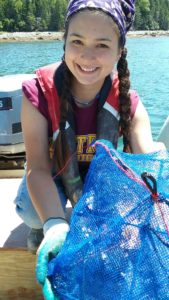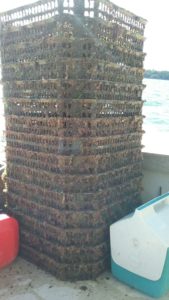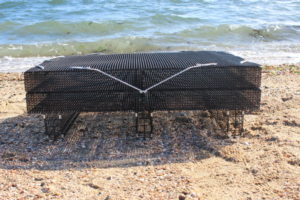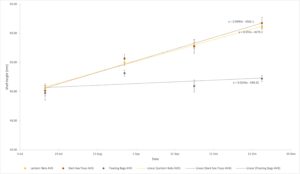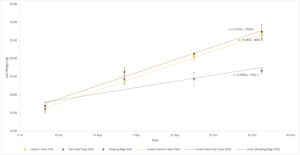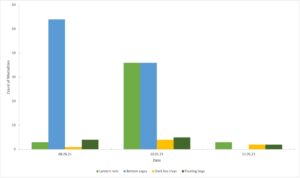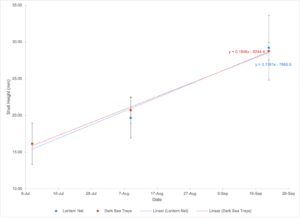Final report for FNE21-976
Project Information
This project sought to assess the viability of four different aquaculture gear types (floating nursery bags, bottom cages, Dark Sea trays, and lantern nets) for the growout of juvenile Atlantic sea scallops (Placopecten magellanicus). We tested these gear types in two locations: at the Pemaquid Oyster Company farm site in the Damariscotta River, and the Pemetic Sea Farms farm site in Union River Bay. We found that the bottom cages were unsuitable for culture; as the cages sank into the mud and smothered the scallops. The floating bags had significantly lower growth rates than the Dark Sea trays and lantern nets in both locations. Dark Sea trays and lantern nets had similar growth rates that were not significantly different, suggesting that Dark Sea trays are a viable option, as lantern nets are traditionally used for growout. Mortality rates were highest in the bottom cages, with 100% mortality, comparable in the Dark Sea trays and lantern nets, and low in the floating bags. An area of further research is a larger-scale comparison of Dark Sea trays and lantern nets, which we are currently writing with support from other collaborators. This project was presented twice: at the SEA Fellows Symposium at the Darling Marine Center in Summer 2021 to researchers and students, and at the Northeast Aquaculture Conference and Exposition in April 2022 to researchers, farmers, educators, and students.
This project seeks to assess four different nursery gear technologies to optimize growth, survival and economic efficiency in farming Atlantic Sea Scallops, Placopecten magellanicus.
The technologies to be tested include one type of floating gear (nursery floating bags), two suspended types of gear (suspended lantern nets and dark sea trays), and one type of bottom gear (bottom cages).
The test farm sites are:
Site 1: The DMC/USDA Lease site at Lowes Cove, Walpole, ME
Site 2: Pemetic Sea Farms Newbury Neck site in Union River Bay, Surry, ME
The Project Objectives are:
- To compare growth rates
- To compare survival rates
- To compare the economics of using the different gear types (the capital costs; the labor involved in deployment, maintenance etc).
If successful, the results of this project will be valuable to farmers looking to enter the sea scallop sector, especially existing aquaculture operations (those looking to diversify income) and fishermen who rely on the competitive wild-caught market. The results of this project will provide new and existing scallop farmers information on the costs vs benefits associated with different gear types, and the comparative growth and survival rates of scallops reared in different gear types.
The Problem:
Maine is leading the way with aquaculture of the popular seafood, the sea scallop (Placopecten magellanicus). The supply-demand conditions of the sea scallop market suggest this species is well suited for aquaculture. The U.S. scallop market has an annual landed value of approximately $380 million(1). Sea scallop landings in Maine for 2017 totaled 802,791 pounds of meat, valued at $9.4 million(1). However, despite strong consumer demand(2), there is a shrinking supply of sea scallops, as State and Federal quotas have been implemented to manage the wild scallop fishery at sustainable levels. Sea scallop landings in Maine during the 2018 season fell by 42% to 563,363 pounds of meat with a dockside value of $5.9 million. This high interannual variability in landings, along with the imbalance between shrinking supply and strong consumer demand, represents an opportunity for the Northeast where there exists a long-standing tradition of scallop fishing, the ideal marine environment for sea scallop farming, a vibrant innovation ecosystem for aquaculture, and existing working waterfront infrastructure.
The Opportunity:
The growth of aquaculture in Maine is proving to be successful. In 2014, Maine’s aquaculture sector had a direct economic impact of $73.4 million in output (3). Including multiplier effects, Maine’s aquaculture sector generated a statewide annual economic contribution of $137.6 million in output, 1,078 full- and part-time jobs, and $56.1 million in labor income in 2014 (3).
There have been several recent initiatives to develop the grow-out phases of sea scallop aquaculture in Maine, and there are an estimated 27 business entities with sea scallops as an approved species on an aquaculture lease or license (4). This indicates a substantial interest and enthusiasm for farming sea scallops that spans Maine’s coastline.
Growth of the sea scallop sector (fishery and farming combined) is dependent on the development of sea scallop farming infrastructure. If this can be achieved, Maine’s scallop harvest could grow by more than three times over the next 10-15 years (2). The industry has the potential to be incredibly profitable given year-round availability and increased pricing in the off seasons in addition to the enhanced value from niche offerings that may be viable under controlled growing conditions.
This Project:
The industry for farm-raised scallops in the U.S. is in its infancy with test sites in place but none at a commercial scale. To date, farming technology borrowed from successful operations in Japan has been used. This includes the use of pearl nets and lantern nets in the nursery stages, followed by “ear hanging” (in which scallops are individually hung on lines) for later grow-out. Whilst inexpensive, there is a key disadvantage to the use of pearl nets and lantern nets in the nursery stages of sea scallop farming: biofouling control. Biofouling is the accumulation of microorganisms, marine animals, and algae. Biofouling can be “soft”, such as algae or “hard”, such as barnacles and mussels. The nets become fouled easily. Once fouled, the nets are heavy, difficult to handle, difficult to access, and difficult to clean.
Pemaquid Oyster Company and Pemetic Sea Farms propose a project to assess growth, survival and economic efficiency using five types of nursery technology.
End User Needs:
The end users of the project results are farmers looking to enter the sea scallop sector, especially existing aquaculture operations (those looking to diversify income) and fishermen who rely on the competitive wild-caught market.
The results of this project offer several potential advantages for end users including: information on the use of farming gear that existing farmers may already have; the costs associated with labor for different gear types; the comparative growth and survival rates of scallops reared in different gear types.
Pemaquid Oyster Company has been farming American oysters in the Damariscotta River, Maine, since 1986.
Pemetic Sea Farms began in 2018 farming American oysters in Union River Bay, Surry, Maine.
Cooperators
- (Researcher)
- - Technical Advisor
- (Researcher)
- (Researcher)
Research
Proposed Materials and Methods (se Results and discussions for modifications made to methods):
The farming cycle for sea scallops is 2.5 to 3 years. As a 12-month project, this project will be unable to assess the whole farming cycle, and focuses on optimizing the nursery phase. The goal of the nursery is to efficiently grow scallops from their small size as juveniles (10-15mm to 40-50 mm shell height) to a size that they can either be sold as a specific product (such as half-shell) or sent on the grow-out stage to final size.
The five technologies to be tested include two types of floating gear (flip farm and nursery floating bags), two suspended types of gear (suspended lantern nets and dark sea trays), and one type of bottom gear (bottom cages). There will be three replicates of each technology used at each site. Pemaquid Oyster Company and Pemetic Sea Farms have experience with all the proposed gear types.
FlipFarm: The FlipFarm system has been designed for the production of oysters but has potential to be adapted for the culture of scallops. The FlipFarm system attaches baskets to a 1 inch polypropylene rope, which is deployed in lines. The FlipFarm system is designed to be robust and to withstand dynamic, semi-exposed marine environments. The baskets can be flipped to manage biofouling. 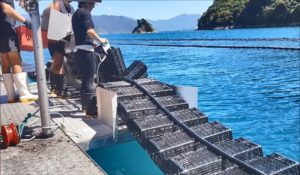
Floating Nursery Bags: Mesh bags containing shellfish are held at the water surface with floats. These types of cages were developed 25 years ago by POC and are now an industry standard for oyster culture. 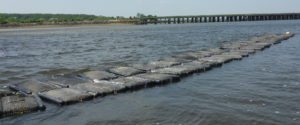
Pearl and Lantern Nets: Lantern nets and pearl nets have the advantage of being light in weight and collapsible, so many can be transported at one time. Lanterns and pearl nets are the standard gear in scallop-producing countries, and they provide good protection with good water flow, but must be frequently maintained against fouling.
Dark Sea Trays: Dark Sea Trays are stackable square shaped trays that are suspended on aluminum poles from longlines. Up to 15 trays can be deployed in one stack, making optimal use of the water column. Water flow and nutrient accessibility is obtained by mesh on all four sides of the trays. Smaller mesh inserts can be used for smaller animals.
Bottom Cages: Bottom cages have the advantage of remaining stable once they are deployed and can be constructed of materials common to aquaculture and the fishing industry, such as oyster bags and wire mesh.
Two experimental farm sites will be used for assessing the growth rate, survival rate, and economic efficacy of the different gear types. The sites are:
Site 1: The Darling Marine Center and United States Department of Agriculture Experimental (DMC/USDA) Lease site at Lowes Cove, Walpole
This site is designated by the Maine Department of Marine Resources (ME DMR) as an Experimental Lease, meaning it is for holding and culturing organisms in research and education projects, not for commercial aquaculture purposes. The lease covers 1.7 acres spread over three tracts (one subtidal and two intertidal) in Lowes Cove and the Damariscotta River. It is easily accessible from the DMC waterfront by foot or by boat, and permits a broad list of species (primarily bivalve shellfish and marine algae) to be cultured using a variety of suspended and bottom culture techniques.
Site 2: Pemetic Sea Farms Newbury Neck site in Union River Bay, Surry
This site is currently designated by ME DMR as a Limited Purpose Aquaculture licensed (LPA) site. The four colocated LPAs total approximately one third of an acre, and are approved for the culture of oysters, sea scallops and marine algae. The site is only accessible by boat. This site had a low temperature of 31 F over the winter of 2019-2020 (from December through to February), and a maximum temperature of 77 F in August 2020. There is a significant freshwater influx from the Union River and salinity can vary from 24 ‰ (parts per million) to 34 ‰ across a tidal cycle.
Juvenile sea scallops will be sourced from wild spat collectors deployed in Fall 2020 by Pemetic Sea Farms and Pemaquid Oyster Company.
A summer undergraduate student intern will be hired to assist with data collection and analysis, and gear deployment and maintenance.
Deployment of juvenile scallops will take place at both sites in May 2021. At the time of deployment, juvenile scallops will be weighed and measured (length, width and depth). Individual gear will be weighed for future determination of biofouling mass. At the time of scallop and gear deployment, environmental data loggers will be deployed at each field site.
Bi-weekly (every 2-weeks) gear will be monitored to document and manage biofouling from May through to November 2021. Biofouling management may include pressure washing, swapping out gear with clean equipment while gear is dried and cleaned, and/or the use of vinegar sprays. Biofouling management practices will vary depending on the type and amount of biofouling. The weight of gear will be recorded as a measure of biofouling mass. Detailed logs of the time/labor involved in biofouling control will be maintained. Some environmental parameters (e.g. salinity, chlorophyll a content of the water) will also be measured every 2-weeks.
Monthly sampling of scallops in each gear configuration will be carried out to determine growth and survival rates from May to November 2021. Digital calipers will be used to measure shell height, length, and inflation of scallops. A portable balance will be used to weigh whole individual scallops to 0.1 g.
Deployed environmental (temperature) data loggers will be retrieved in November and data will be downloaded.
A general linear fixed effects model analysis of variance (ANOVA) will be used to compare treatment means and determine significant differences for the parameters measured. Significance will be determined at the 0.95 probability level.
Modifications to methods:
We did not end up using the FlipFarm system; as the permitting change to operate the Flip Farm was not approved by the Maine DMR by the beginning of the project. Additionally, sea scallops cannot tolerate exposure to air for long periods of time, and the Flip Farm system relies on drying out the gear to get rid of biofouling. Additionally, due to sea scallop spat availability, we conducted a reduced version of this project at the Union River Bay site and the full project at the Darling Marine Center lease site in Lowes Cove, Walpole. The Union River Bay scallops were spat that were collected in Union River Bay in the winter of 2020-2021. Scallops were placed into a bottom cage and in a floating cage (not a floating bag) in Union River Bay but they died. The scallops in the bottom cages were smothered by anoxic mud. The floating cage scallops died gradually over a period of weeks; and showed signs of stress, e.g. the mantle receded from the shell. In conclusion, wave action at this site was too rigorous for sea scallops to be kept on the surface. We collected growth data for scallop spat in Union Bay grown in lantern nets and Dark Sea trays.
Sea scallops were deployed in three replicates of four different gear types (floating bags, lantern nets, Dark Sea trays, and bottom cages) at the Darling Marine Center on July 16, 2021. Scallops were measured for shell height, shell width, shell inflation, and live weight in groups of 30 before deployment. ANOVA tests were used to determine if there was any significant difference between the groups. The initial shell height for juvenile scallops ranged from 35mm-65mm. Stocking densities for each gear type are shown in Table 1.
Table 1: Gear types, stocking densities, and total number of scallops for gear deployed at the Darling Marine Center.
|
Gear Type |
Stocking Density |
Number of each gear type |
Tag #s |
Total Number of Scallops |
|
Lantern nets |
30 scallops/tier; 90 scallops/net |
3 |
1-9 |
270 |
|
Bottom cages |
30 scallops/cage |
3 |
10-12 |
90 |
|
Dark sea trays |
30 scallops/tray |
3 |
13-15 |
90 |
|
Floating nursery bags |
60 scallops/bag |
3 |
16-18 |
180 |
|
TOTAL |
630 |
|||
After deployment, gear was checked for biofouling and scallops were measured for shell height and live weight monthly until November 2021.
Results:
The bottom cages had the most mortality of any gear type. The cages sank into the soft mud on the bottom of the river, resulting in total mortality (100%) by November 2021. There was not enough data collected to establish growth rate, and scallops appeared to have died around the same size of their initial measurements.
The floating nursery bags had 6.1% mortality with a growth rate of 0.01 mm ᐧ day-1 (Figure 1). While scallops in this treatment had a low mortality rate, they were visibly much smaller than scallops grown in lantern nets or Dark Sea trays, in accordance with the low growth rate. The primary form of biofouling on the floating bags was sea lettuce. These scallops were also darker in color than the scallops grown in the middle of the water column.
Scallops grown in the lantern nets had a mortality rate of 4.4% and an average growth rate of 0.093 mm ᐧ day-1 (Figure 1). In November, we noticed a large growth edge on these scallops, but they also showed a lot of chipping on their shells. This could have been due to handling or scallops moving around inside the nets. The primary form of biofouling on the lantern nets were tunicates, which were easily removed by pressure washing the nets.
The Dark Sea trays performed similarly to the lantern nets; with a mortality rate of 7.7% and an average growth rate of 0.099 mm ᐧ day-1 (Figure 1). Scallops in the Dark Sea trays also had a prominent growth edge and were quite active during handling. The Dark Sea trays had the most biofouling of the gear types; primarily tunicates. Over time, it became difficult to separate the trays from one another due to the biofouling; however pressure washing helped to remove most of it.
ANOVA tests showed no significant difference between shell heights and live weights of scallops grown in lantern nets and Dark Sea trays. There was a significant difference in growth between lantern nets and Dark Sea trays and scallops grown in floating bags. Scallops grew significantly more in Dark Sea trays and lantern nets than in floating bags.
Figure 1: Shell height mean (in mm) over July-November 2021 of sea scallops in 3 gear treatments: Dark Sea trays (DST), lantern nets, and floating bags, located at the Darling Marine Center's experimental farm site in Lowes Cove, Walpole. Average growth rate (mm ᐧ day-1) for each gear type is displayed via trend line. Error bars represent standard deviation.
Figure 2: Live weight (in grams) over July-November 2021 of sea scallops in 3 gear treatments: Dark Sea trays (DST), lantern nets, and floating bags, located at the Darling Marine Center's experimental farm site in Lowes Cove, Walpole. Average growth rate (g ᐧ day-1) for each gear type is displayed via trend line. Error bars represent standard deviation.
Figure 3: Count of mortalities at the Darling Marine Center study site over August-November 2021 in 4 gear treatments: Dark Sea trays, lantern nets, floating bags, and bottom cages.
Scallops at the Union Bay site had similar growth rates in Dark Sea trays (0.185 mm ᐧ day-1) and lantern nets (0.176 mm ᐧ day-1) (Figure 4). An ANOVA performed on this data showed no significant difference in shell height and live weight between these treatments.
Figure 4: Shell height mean (in mm) over July-September 2021 of sea scallops in 2 gear treatments: Dark Sea trays (DST) and lantern nets, located in Union River Bay, Surry, Maine. Average growth rate (mm ᐧ day-1) for each gear type is displayed via trend line. Error bars represent standard deviation.
This project sought to compare different aquaculture gear types for the grow-out of juvenile Atlantic sea scallops. We tested four gear types (floating nursery bags, Dark Sea trays, lantern nets, and bottom cages) at the Darling Marine Center's experimental lease in Lowes Cove, Walpole, and a reduced version of this project in Union River Bay. Dark Sea trays and lantern nets had the best growth rates over a 4-month period from July to November 2021. While the floating bags had a low mortality rate, the growth rate was very slow. The bottom cages proved to be an inappropriate gear type for both locations; as they sank into the mud which killed the scallops. Future studies are currently being developed to further investigate Dark Sea trays for scallop culture, as this project suggests that scallops grow just as well in Dark Sea trays as compared to lantern nets.
Education & Outreach Activities and Participation Summary
Participation Summary:
This project was presented at the SEA Fellows Symposium in August 2021 to undergraduate and graduate students and faculty of the UMaine Darling Marine Center as well as interested members of the public. A copy of the poster that was presented has been uploaded to the NE SARE site.
This project will also be presented in poster format in April 2022 at the Northeast Aquaculture Conference and Exposition (NACE) in Portland, Maine to a variety of aquaculture researchers, farmers, and students.
Learning Outcomes
Project Outcomes
Using bottom cages to culture scallops turned out to be inappropriate for this study because the cages sank into the mud and smothered the scallops. A modification that may help prevent this is to attach a small platform to the cages so they would sit on top of the substrate instead of sink into it. Bottom cages may also be suitable for sites that have a rocky or sandy substrate instead of mud. This could be addressed in a future study.
The floating nursery bags proved to be unsuitable for the Union River Bay site, where too much wave action led to mortality. Additionally, the low growth rate for scallops in floating bags at the Lowes Cove site suggests that floating bags are not ideal for scallop culture compared to lantern nets and Dark Sea trays, where scallops were grown in the middle of the water column.
One challenge that we had is that sea scallops are very sensitive to desiccation and do not react well to being handled, especially in warm temperatures. This meant we had to act quickly to collect measurements and clean biofouling off of the gear, to get scallops back in the water as quickly as possible. A group of 30 scallops (one tier of a lantern net) was found dead, and we believe that this mortality event was due to measurements and handling that occurred the month prior, e.g. the scallops were left in a bucket for too long while we were completing measurements. The sensitivity of sea scallops to handling could prove to be an issue for potential farmers. This emphasizes the importance of employing gear types that resist heavy biofouling, so the scallops do not need to be disturbed as often.
The results from this project could benefit potential or current sea scallop farmers who are interested in growing sea scallops in gear types besides the traditional lantern net. The results from this project suggest that sea scallops grow just as well in Dark Sea trays as they do in lantern nets, and we intend to investigate this further with a future study. Bottom cages and floating nursery bags proved to be unsuitable for our farm sites, but modifications to these gear types could result in a more positive outcome, and they may work well for other farm sites.
Information Products
- The effects of different gear types on farming Atlantic Sea Scallops (Placopecten magellanicus) (Conference/Presentation Material)
